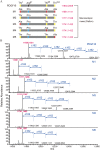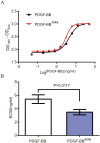Identification and Functional Characterization of Glycosylation of Recombinant Human Platelet-Derived Growth Factor-BB in Pichia pastoris
- PMID: 26701617
- PMCID: PMC4689512
- DOI: 10.1371/journal.pone.0145419
Identification and Functional Characterization of Glycosylation of Recombinant Human Platelet-Derived Growth Factor-BB in Pichia pastoris
Abstract
Yeast Pichia pastoris is a widely used system for heterologous protein expression. However, post-translational modifications, especially glycosylation, usually impede pharmaceutical application of recombinant proteins because of unexpected alterations in protein structure and function. The aim of this study was to identify glycosylation sites on recombinant human platelet-derived growth factor-BB (rhPDGF-BB) secreted by P. pastoris, and investigate possible effects of O-linked glycans on PDGF-BB functional activity. PDGF-BB secreted by P. pastoris is very heterogeneous and contains multiple isoforms. We demonstrated that PDGF-BB was O-glycosylated during the secretion process and detected putative O-glycosylation sites using glycosylation staining and immunoblotting. By site-directed mutagenesis and high-resolution LC/MS analysis, we, for the first time, identified two threonine residues at the C-terminus as the major O-glycosylation sites on rhPDGF-BB produced in P. pastoris. Although O-glycosylation resulted in heterogeneous protein expression, the removal of glycosylation sites did not affect rhPDGF-BB mitogenic activity. In addition, the unglycosylated PDGF-BBΔGly mutant exhibited the immunogenicity comparable to that of the wild-type form. Furthermore, antiserum against PDGF-BBΔGly also recognized glycosylated PDGF-BB, indicating that protein immunogenicity was unaltered by glycosylation. These findings elucidate the effect of glycosylation on PDGF-BB structure and biological activity, and can potentially contribute to the design and production of homogeneously expressed unglycosylated or human-type glycosylated PDGF-BB in P. pastoris for pharmaceutical applications.
Conflict of interest statement
Figures






Similar articles
-
Cloning and expression of recombinant human platelet-derived growth factor-BB in Pichia Pink.Cell Mol Biol (Noisy-le-grand). 2016 Jul 31;62(8):45-51. Cell Mol Biol (Noisy-le-grand). 2016. PMID: 27545214
-
High level expression, efficient purification and bioactivity assay of recombinant human platelet-derived growth factor AA dimer (PDGF-AA) from methylotrophic yeast Pichia pastoris.Protein Expr Purif. 2013 Oct;91(2):221-7. doi: 10.1016/j.pep.2013.08.008. Epub 2013 Aug 23. Protein Expr Purif. 2013. PMID: 23978536
-
Expression of recombinant human IL-4 in Pichia pastoris and relationship between its glycosylation and biological activity.Protein Expr Purif. 2014 Apr;96:1-7. doi: 10.1016/j.pep.2014.01.005. Epub 2014 Jan 24. Protein Expr Purif. 2014. PMID: 24468271
-
Expression of heterologous proteins in Pichia pastoris: a useful experimental tool in protein engineering and production.J Mol Recognit. 2005 Mar-Apr;18(2):119-38. doi: 10.1002/jmr.687. J Mol Recognit. 2005. PMID: 15565717 Review.
-
Characterization of N-linked glycosylation on recombinant glycoproteins produced in Pichia pastoris using ESI-MS and MALDI-TOF.Methods Mol Biol. 2009;534:213-23. doi: 10.1007/978-1-59745-022-5_16. Methods Mol Biol. 2009. PMID: 19277549 Review.
Cited by
-
Prostate Cancer Risk-Associated Single-Nucleotide Polymorphism Affects Prostate-Specific Antigen Glycosylation and Its Function.Clin Chem. 2019 Jan;65(1):e1-e9. doi: 10.1373/clinchem.2018.295790. Epub 2018 Dec 11. Clin Chem. 2019. PMID: 30538125 Free PMC article.
-
Pathway engineering facilitates efficient protein expression in Pichia pastoris.Appl Microbiol Biotechnol. 2022 Sep;106(18):5893-5912. doi: 10.1007/s00253-022-12139-y. Epub 2022 Aug 30. Appl Microbiol Biotechnol. 2022. PMID: 36040488 Review.
-
Engineering a highly active thermophilic β-glucosidase to enhance its pH stability and saccharification performance.Biotechnol Biofuels. 2016 Jul 20;9:147. doi: 10.1186/s13068-016-0560-8. eCollection 2016. Biotechnol Biofuels. 2016. PMID: 27446236 Free PMC article.
-
Cytokinetic engineering enhances the secretory production of recombinant human lysozyme in Komagataella phaffii.Microb Cell Fact. 2024 Jun 18;23(1):179. doi: 10.1186/s12934-024-02434-w. Microb Cell Fact. 2024. PMID: 38890717 Free PMC article.
-
Recombinant Protein Expression System in Corynebacterium glutamicum and Its Application.Front Microbiol. 2018 Oct 26;9:2523. doi: 10.3389/fmicb.2018.02523. eCollection 2018. Front Microbiol. 2018. PMID: 30416490 Free PMC article. Review.
References
Publication types
MeSH terms
Substances
LinkOut - more resources
Full Text Sources
Other Literature Sources

